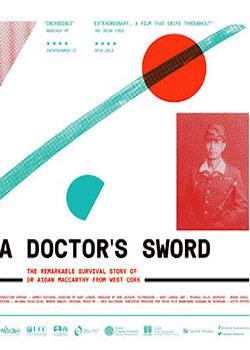A Doctor’s Sword

Directed by Gary Lennon
Screened at the Bertha DocHouse
18 March 2017
Review by Roger Macy
Does an Irish documentary film deserve space in the Japan Society Review? Only in that it was partly filmed in Japan and the makers have sought to make some generalisations about Japan after its screening in London.
A Doctor’s Sword had the potential to explore an interesting, off-beat topic – the relationship of Ireland to Japan during WorldWar II. In my own researches into the period, I have noticed that Japanese-sponsored, English-language material on culture, even tourist promotion material, is likely to turn up in Ireland – the only English-speaking country in the world with which Japan did not engage in warfare. I have also noticed the intense annoyance of the British Foreign Office at the tardiness of bringing to heel the Japanese representative to Dublin at the end of the war. The complexity of the subject expands when one considers the 50,000 Irishmen who served – for their old colonial masters – in the British Forces in WorldWar II.
Aidan MacCarthy was a newly qualified medical doctor from County Cork when he signed up in London in 1939 with the RAF, “for the money”, his family report in the film. When caught in the fall of Singapore, MacCarthy’s troubles and journeys begin. The film duly recounts the well-known maltreatment of prisoners of war (POW) by Japan in WorldWar II, but completely overlooks the much worse treatment of those without POW status. Having got in so deep, one can surely forgive MacCarthy when we catch sight of his Japanese POW record as ‘Joseph MacCarthy, British’, but it’s a detail the film accidentally gives us and is not commented on. The real Aidan MacCarthy lived an honourable life as a doctor in Ireland after the war but, unfortunately didn’t write of his experiences until the 1990s, after a stroke. We hear his recorded voice on the radio from that time, presenting himself as purely a “Catholic Irishman”. Even 40 years later – and even now, well into the third millennium – the dual identity of many of those in Ireland cannot, it seems, be openly faced. It’s not just that the border-crossing between Ireland and the U.K. in 1939 is invisible to the viewer in this film, the heroic fight against the Axis powers, in which MacCarthy took part, is implicitly owned by anyone of MacCarthy’s identity.
With so much history suppressed, the film devotes itself to the titular sword, residing since 1945 in County Cork, together with a photograph of a Japanese officer, wearing same sword, offering ‘this’, i.e., the photograph, as a token of friendship. Of course, the surrender of swords was the outwardly and bodily token of a hundred thousand surrenders and more. The evident fact that, when jailer became prisoner, this particular sword did not make its way up the chain of command, is a misappropriation long since time-barred. For this film, however, its ‘gift’ was a unique token of everlasting friendship, worthy of far more time than MacCarthy ever seemed to have spent on it.
The film’s director, Gary Lennon, was present for a Q&A at the Bertha Dochouse. He had been to Japan. He wanted to tell us how “the Japanese” are not facing up to their WorldWar II history.

